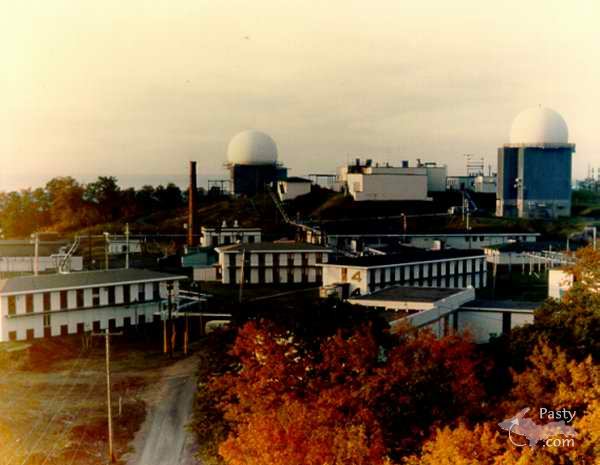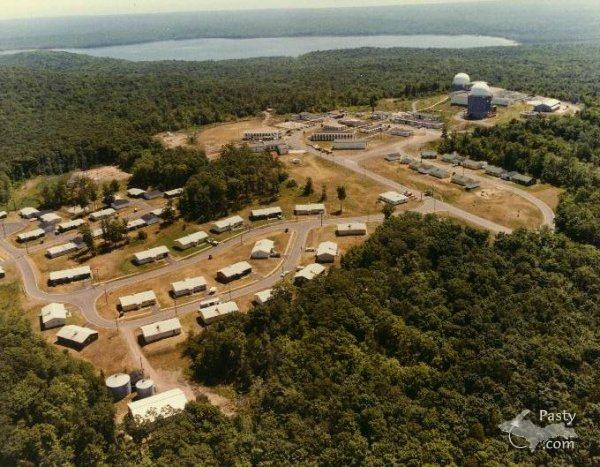
The 665th Aircraft Control & Warning Squadron was active for nearly four decades. From the moment of its activation in 1951 the 665th AWCS played a significant role in the Keweenaw both economically and socially. The social relationship between station and region was unique with respect to similar installations.
A Hasty Beginning
July 11th, 1950 marks the start of the Korean war. The Soviets were building a huge offensive military force, and refusing to cooperate with the Allies regarding East Germany. The dawn of the scientific-technical revolution is forcing world powers to change tactics both offensive and defensive. The Secretary of the Air Force knew our state of surveillance had left the country vulnerable to newly developing jet aircraft, particularly long range bombers in development by the Soviets. To exacerbate the situation the Soviets were beginning to test America’s resolve with frequent incursions near the northern border. Rapid development in missile technology has changed warfare forever:
“No longer is the enemy on the far side of the globe, they are on the other side of a panel of buttons controlling the fate of the world.” [2]
To counter the high speed and altitude capable with these modern jet planes and missiles the country needed to develop more powerful surveillance via radar technology. The Department of Defense developed a two part plan. The first portion focused on offensive first strike capabilities while the second (defensive) portion included the development of an array of powerful radar surveillance stations. The proposed array would consist of 28 radar stations placed strategically throughout American territory. The Keweenaw Peninsula was selected for the development of one of these stations.

This station would be known as the 665th Aircraft Control & Warning Station, and its development along with the other 27 stations required significant funding. The squadron initially utilized AN/FPS-3 and AN/FPS-5 radars, and it saw several upgrades throughout its service. With tensions building between the U.S. and U.S.S.R. the Secretary of the Air Force requested that the construction plans be accelerated. Feeling pressure from foreign relations and recognizing the necessity for such an array, the Secretary of Defense approved the accelerated plans. With this approval the Corps of Engineers, under the direction of the Air Force, began the design and construction of the stations. The 665th Aircraft Control & Warning Squadron was activated on November 27th 1950, but was not fully operational until April 24th 1951. Even so this was an impressive feet of engineering, within a year of the start of the Korean War America designed and built the most advanced surveillance array in the world.
Considering the remote location of the 665th ACWS this is even more impressive and would certainly not have been possible without the surprising amount of resources and labor available from the Keweenaw region: “The materials used and the labor hired came from surrounding communities, which adds to the already significant economic impact the station has on the area.” [5] Though the station was operational by early 1951 it was far from complete. It had no amenities in place and hardly enough facilities to be considered an installation. During the first year of operation it was four to six men per room. Some would argue that the close quarters helped the cold winter nights of the Keweenaw become bearable. Veteran Art Simila recalled “There were no recreational facilities at the station then… People assumed things had to get better because they couldn’t get any worse.” [7]
Rooted in the Keweenaw

Besides the military presence of the 665th ACWS, the station had a profound impact on the Keweenaw economy. The day-to-day functions of the station were much broader than its primary military responsibility. To keep everything running smoothly the station employed a significant workforce, at least by Keweenaw standards. Of the total 275 personal serving the station only 100 were quartered on the base. At least 175 personnel were employed civilians making a living at the station, more still, of the 100 on station, were probably regular employees whose duties required their presence full time. Needless to say, the 665th ACWS became the largest single economic driver in the Keweenaw since the mining days.
The station made good use of recreational facilities, and not just for adults. Each of the 45 homes built on the base housed a family, yielding roughly 100 children. Additionally, from the employed families who lived in the surrounding communities there were another 100 children. With a total of 200 children on base the playground and other recreational facilities had a significant role. The 665th ACWS was essentially a small city of its own with a primary military responsibility. Keeping children safe meant keeping them occupied.
“It has been buffeted by the winds of four seasons and half buried in snow during three decades of winters. Its 45 homes have probably seen more children than most hotels.” [5]
The 665th ACWS was unique with regards to most stations. It is hard to pinpoint every variable which effected the station in a special way, but the genuine welcoming culture of the Keweenaw no doubt played an important role in the attitude of the station and her servicemen. Berghefer, a veteran of the station, recalled 19 former Air Force personnel who were stationed at the base and later retired to the Calumet-Laurium area. This is unique from most stations, generally servicemen only stay on station for a few short years and then they are out as fast as they got in. The men of the 665th ACWS certainly had downtime and would visit the local communities on the weekends or go on a short adventure in the surrounding wilderness: “Many of us have relatives in the area. A good number also plan their vacations in the U.P.”, Berghefer said. [3] The opportunity the Keweenaw offered supported the morale of the station and in turn the Keweenaw received attention of many proud servicemen, for the long haul. The beautiful wilderness of the Keweenaw however did not offer all the curves that these men were interested in: “A lot of us including myself married local girls and have made our homes here.” Berghefer stated. [3]
Attitudes at the station had changed since the initial activation of a partially constructed station. Now the station was a lively part of an active community. Servicemen took pride in not only their military duty but their menial tasks as well. The culture of the Keweenaw is very hands-on/ do it yourself. The work ethic displayed by locals employed by the station at least cultivated, if nothing else, a solid work ethic in the servicemen as well. A writer for the Houghton Daily Mining Gazette noticed while touring the station,“The base has a look of newness about it that suggests the ultimate in paint-up, fix-up, clean-up campaigns and a stringent program of maintenance.” [5].
One of these “stringent” programs of course was the self-help program loosely implemented by command. Brigadier General Kenneth W. North, the regional commander of NORAD awarded the station first place for self-sufficiency and appearance of the station. “The Station made use of the ‘self-help’ program, whereby personnel at the station made repairs and improvements to the site without the use of outside labor. The ‘self-help’ program increases pride, is faster, and costs less.” [6]
Personnel of the 665th ACWS took pride in their station. After its construction it developed into more than a single station in an array; it was home. Not many stations take the time to recognize “Yard of the Week” or “building of the week.” The culture of the Keweenaw complemented and cultivated the 665th Aircraft and Warning Station; and in return the station stimulated the local economy, and offer plenty of retired servicemen looking for a place to call home.
Primary Sources:
1: 665th Radar Squadron welcomes you to Calumet Air Force Station Unknown, 665TH Radar Squadron Calumet Air Force Station. Dept. of the Air Force. Washington, D.C. (1987, May), Pages 1-24. [Scanned Document]
2: Tom Scanlan. New Perspectives on Michigan’s Copper Country: Calumet Air Force Station. Quincy Mine Hoist Association, Hancock, Michigan, 2007, pages 153-157.
3: “Calumet Air Station this weekend ” Jul 14 1995. Copper Country Vertical File: Michigan Tech Archives & Copper Country Historical Collections. [CCVF]
4: “Calumet AFS marks 25th year of ADC” Mar 20 1971. CCVF
5: “Calumet Air Base: We’re glad it’s here” Sep 17 1981. CCVF
6: “Calumet Air Force Station Honored” Jul 3 1983. CCVF
7: “Calumet AFS observes 35th year” Mar 29 1985. CCVF
Secondary Sources:
8: Winkler, David F. Searching the Skies: The Legacy of the United States Cold War Defense Radar Program USAF Hq Air Combat Command, 1997, 192 pages, page 22, 123.
9: Cornett, Lloyd H. & Johnson, Mildred W., A Handbook of Aerospace Defense Organization (1946-1980), Office of History ADC, Peterson AFB, Colorado, 31 Dec 1980, 179 pages, page 158.
10: NORAD/CONAD Historical Summary Jan-Dec 1966, Command History Division, HQ NORAD/CONAD, Unclassified, Dec, 12, 2012, pages 28-31, Backup Intercept Control Systems. [PDF]
11: Whorton, M. Evaluating and Managing Cold War era Historic Properties :The Cultural Significance of the U.S. Air Force Defensive Radar Systems: N. p., 1999. [PDF]
12: Pasty.com photo archive,https://www.pasty.com/discus/messages/713/1143.html#PN
Further Reading:
